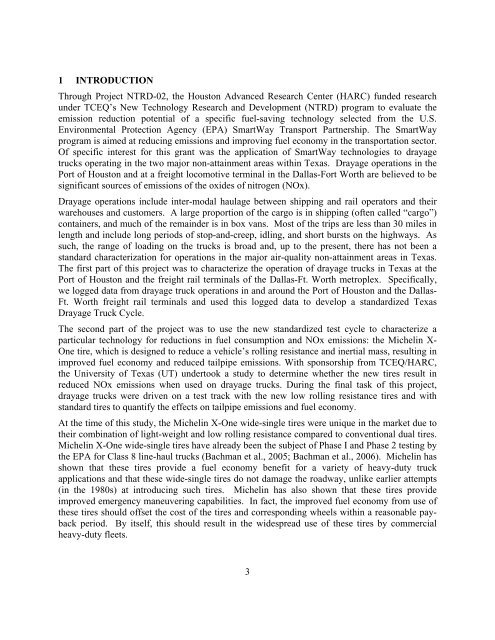NTRD-02 Final Project Report The Effects of Low Rolling Resistance ...
NTRD-02 Final Project Report The Effects of Low Rolling Resistance ...
NTRD-02 Final Project Report The Effects of Low Rolling Resistance ...
You also want an ePaper? Increase the reach of your titles
YUMPU automatically turns print PDFs into web optimized ePapers that Google loves.
1 INTRODUCTION<br />
Through <strong>Project</strong> <strong>NTRD</strong>-<strong>02</strong>, the Houston Advanced Research Center (HARC) funded research<br />
under TCEQ’s New Technology Research and Development (<strong>NTRD</strong>) program to evaluate the<br />
emission reduction potential <strong>of</strong> a specific fuel-saving technology selected from the U.S.<br />
Environmental Protection Agency (EPA) SmartWay Transport Partnership. <strong>The</strong> SmartWay<br />
program is aimed at reducing emissions and improving fuel economy in the transportation sector.<br />
Of specific interest for this grant was the application <strong>of</strong> SmartWay technologies to drayage<br />
trucks operating in the two major non-attainment areas within Texas. Drayage operations in the<br />
Port <strong>of</strong> Houston and at a freight locomotive terminal in the Dallas-Fort Worth are believed to be<br />
significant sources <strong>of</strong> emissions <strong>of</strong> the oxides <strong>of</strong> nitrogen (NOx).<br />
Drayage operations include inter-modal haulage between shipping and rail operators and their<br />
warehouses and customers. A large proportion <strong>of</strong> the cargo is in shipping (<strong>of</strong>ten called “cargo”)<br />
containers, and much <strong>of</strong> the remainder is in box vans. Most <strong>of</strong> the trips are less than 30 miles in<br />
length and include long periods <strong>of</strong> stop-and-creep, idling, and short bursts on the highways. As<br />
such, the range <strong>of</strong> loading on the trucks is broad and, up to the present, there has not been a<br />
standard characterization for operations in the major air-quality non-attainment areas in Texas.<br />
<strong>The</strong> first part <strong>of</strong> this project was to characterize the operation <strong>of</strong> drayage trucks in Texas at the<br />
Port <strong>of</strong> Houston and the freight rail terminals <strong>of</strong> the Dallas-Ft. Worth metroplex. Specifically,<br />
we logged data from drayage truck operations in and around the Port <strong>of</strong> Houston and the Dallas-<br />
Ft. Worth freight rail terminals and used this logged data to develop a standardized Texas<br />
Drayage Truck Cycle.<br />
<strong>The</strong> second part <strong>of</strong> the project was to use the new standardized test cycle to characterize a<br />
particular technology for reductions in fuel consumption and NOx emissions: the Michelin X-<br />
One tire, which is designed to reduce a vehicle’s rolling resistance and inertial mass, resulting in<br />
improved fuel economy and reduced tailpipe emissions. With sponsorship from TCEQ/HARC,<br />
the University <strong>of</strong> Texas (UT) undertook a study to determine whether the new tires result in<br />
reduced NOx emissions when used on drayage trucks. During the final task <strong>of</strong> this project,<br />
drayage trucks were driven on a test track with the new low rolling resistance tires and with<br />
standard tires to quantify the effects on tailpipe emissions and fuel economy.<br />
At the time <strong>of</strong> this study, the Michelin X-One wide-single tires were unique in the market due to<br />
their combination <strong>of</strong> light-weight and low rolling resistance compared to conventional dual tires.<br />
Michelin X-One wide-single tires have already been the subject <strong>of</strong> Phase I and Phase 2 testing by<br />
the EPA for Class 8 line-haul trucks (Bachman et al., 2005; Bachman et al., 2006). Michelin has<br />
shown that these tires provide a fuel economy benefit for a variety <strong>of</strong> heavy-duty truck<br />
applications and that these wide-single tires do not damage the roadway, unlike earlier attempts<br />
(in the 1980s) at introducing such tires. Michelin has also shown that these tires provide<br />
improved emergency maneuvering capabilities. In fact, the improved fuel economy from use <strong>of</strong><br />
these tires should <strong>of</strong>fset the cost <strong>of</strong> the tires and corresponding wheels within a reasonable payback<br />
period. By itself, this should result in the widespread use <strong>of</strong> these tires by commercial<br />
heavy-duty fleets.<br />
3

















